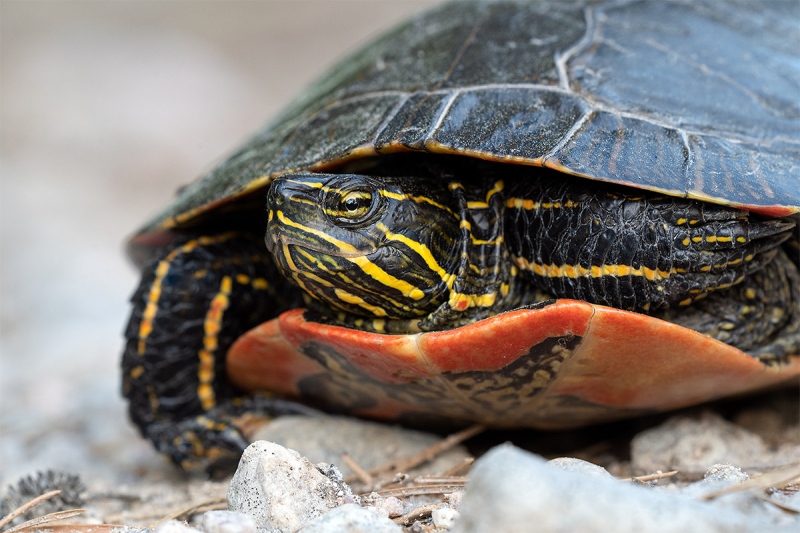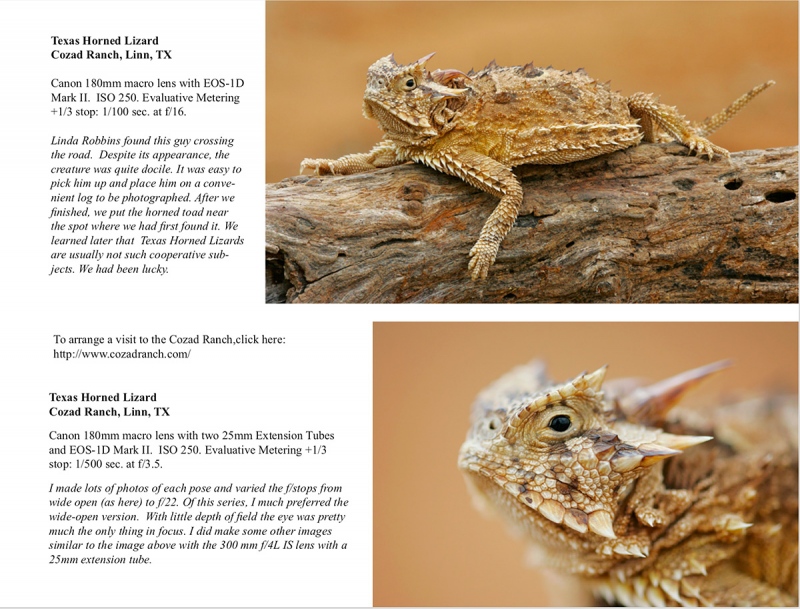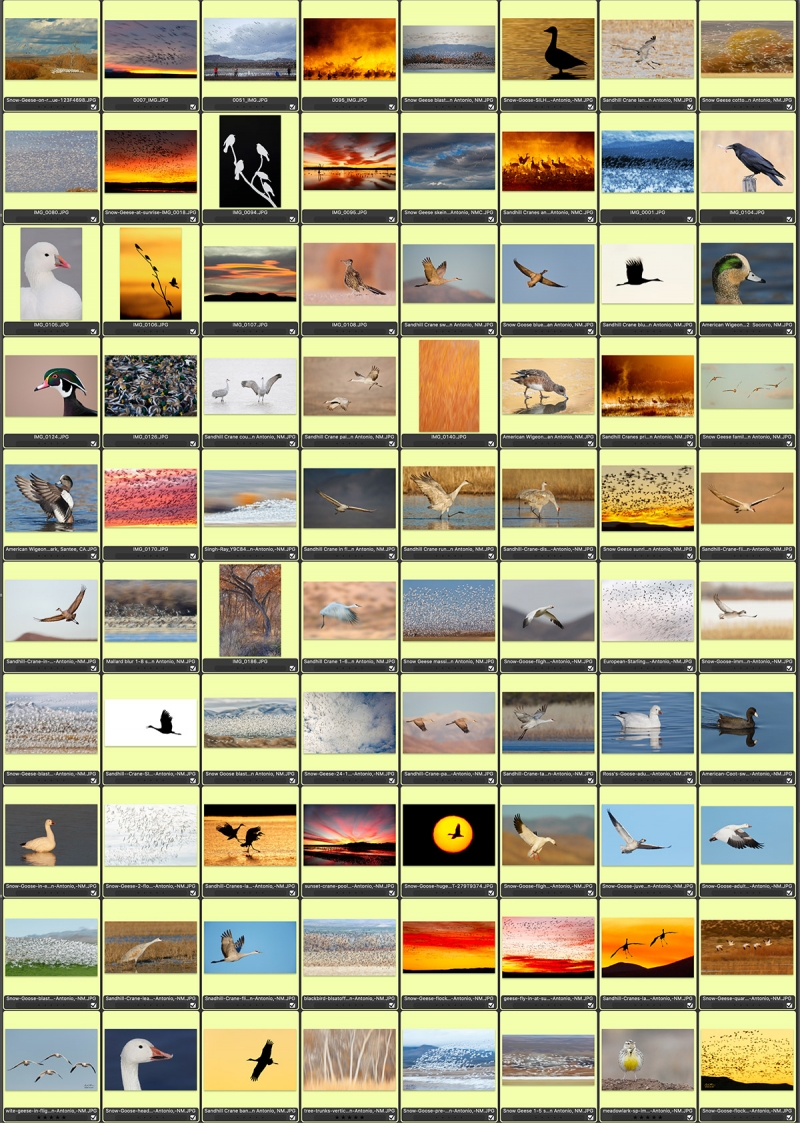What’s Up
Two brand new BAA publications will be released soon. The first will be The BAA Middle of Florida Photographic Site Guide, co-written and co-illustrated by Joe Przybyla and yours truly. Frog Pond Adventures/A Guide to Photographing Frogs and Toads was written and illustrated by Andrew McLachlan and edited for readability by yours truly. Each of these new e-Guides is lavishly illustrated with images that will educate and inspire. Both will sell for $50 via electronic download.
Please take a good look at the turtle image below and see if you can come up with the answer I am looking for in the Image Design Quiz.
Coming Soon
I will be announcing the Fort DeSoto Fall Sandbar Secrets IPT and one or two Bosque IPTs soon.
FlexShooter Pro Update
We currently have FlexShooter Pro heads in stock here. We are sold out on the newly-arrived FLN-60 BigFeet recently re-designed to perfection for the Nikon 600 VR.


BIRDS AS ART
BIRDS AS ART is registered in the U.S. Patent and Trademark Office.
Money Saving Reminder
If you need a hot photo item that is out of stock at B&H, would enjoy free overnight shipping, and would like a $50 discount on your first purchase, click here to order and enter the coupon code BIRDSASART at checkout. If you are looking to strike a deal on Canon or Nikon gear (including the big telephotos) or on a multiple item order, contact Steve Elkins via e-mail or on his cell at (479) 381-2592 (Eastern time) and be sure to mention your BIRDSASART coupon code and use it for your online order. Steve currently has several D850s in stock along with a Nikon 600mm f/4 VR. He is taking pre-orders for the new Nikon 500 P and the Nikon Z6 mirrorless camera body.
Gear Questions and Advice
Too many folks attending BAA IPTs and dozens of photographers whom I see in the field and on BPN, are–out of ignorance–using the wrong gear especially when it comes to tripods and more especially, tripod heads… Please know that I am always glad to answer your gear questions via e-mail. Those questions might deal with systems, camera bodies, accessories, and/or lens choices and decisions.
|
|
|
This image was created on June 15, 2019, at Basket Lake, near Dryden, Ontario Canada. Lying on the road I used the handheld Sony FE 100-400mm f/4.5-5.6 GM OSS lens (at 400mm) and the high mega-pixel Sony Alpha a7R III Mirrorless Digital camera body. ISO 1000: 1/125 sec. at f/9 in Manual mode. Exposure determined by Zebras with ISO on the rear dial … AWB at 6:47pm on a clear afternoon. Flexible Spot (S) C (tracking) AF was active at the moment of exposure. The selected AF point was placed on the subject’s eye. Click on the image to enjoy a larger version. Painted Turtle sunning |
Tame Stuff …
When I sent this image to my friend Andrew McLachlan to confirm the ID, he replied: They are usually rather skittish …. Anita North and I were exploring some back roads around Basket Lake driving a very noisy four-wheeled gas-powered cart. When we passed this turtle sunning itself on the side of the road, I called out, “Stop.” We got our lenses and approached with great caution assuming that most turtles would be very shy. This one was not. We started at about 15 feet and once we realized that it was quite content and unafraid, I was easily able to approach within four feet (at which point today’s featured image was created). Anita was using her 500 PF and needed to stay well back as the minimum focusing distance (MFD) is 3.0 meters, about nine feet, ten inches. That as compared to an incredible .98 meters for the SONY (and the Canon) 100-400 lenses. Note: .98 meters is about 3 feet, two and one-half inches.
More than a decade ago I came across a Texas Horned Toad on a dirt road. It was silly-tame. I picked up and posed it on various branches on the weathered branches of a dead tree. I used my Canon 180mm macro lens and — over the course of an hour — made a zillion images varying my perspective and framing every few minutes. And re-positioning the creature. When I showed the images to some friends in Texas and told them the story, they were astounded: “Those buggers always run and hide whenever you even look at them.” Over the years I have run into more than my share of incredibly tame creatures that are supposed to be very shy … Scroll down to see two of the horned toad images and an excerpt from ABP II.
The toad that I mentioned in yesterday’s short blog post was another in what has been a long series of wonderfully lucky encounters.
SONY a7R iii for Close Work
As seen here often on the blog, the a7R iii/100-400 GM is superb for close work be it avian, flowers, reptiles and amphibians, or any other medium-sized or tightly framed subjects. On the UK Puffins and Gannets and Red Kites IPT it will always be on my shoulder via the Black Rapid Curve Breathe Strap. I will have the Induro GIT 304L/FlexShooter Pro-mounted Nikon 600 VR along for most of our sessions. The SONY rig will again be on my shoulder as above but my “big” lens will be the Induro GIT 204L/FlexShooter Pro-mounted Nikon 500 PF. With the lighter lens, I may go to the FlexShooter Mini; more on that here soon.
Image Design Quiz
In what way would this image have been improved if I had pointed my lens 3/8 of an inch to my right (sorry — “left” was a confusing my-bad error). Please be very specific. There would be two benefits to re-framing this image slightly; I am looking for the really big reason.
|
|
ABP II excerptClick on the image to see a sharper version if you wish to read the fine print. |
ABP II Excerpt
The screen capture above is an excerpt from the Setups and Backyard Photography Gallery in The Art of Bird Photography II (ABP II: 916 pages, 900+ images on CD or by electronic download.) Every time I scroll through ABP II, I marvel at the quality and the amount of both information and images. I think to myself, “So many folks could learn so much from ABP II; it is the most under-utilized resource in the wonderful world of bird photography. Along with BPN … For those who read the fine print an online search seemed to indicate that Johnny Cozad’s ranch is no longer open to visiting photographers. If I am wrong, please let us know.
Note: overseas folks or those who wish to enjoy the convenience of an electronic download can do so by clicking here.
|
|
Bosque del Apache 2019 IPTsNotice the incredible variety of images that you can learn to make by developing your skills and your creative vision on a BAA IPT. |
2019 Bosque del Apache IPTs
Return to Bosque Reduced Rate Scouting IPT #1. NOV 26-28, 2019 — 3 FULL DAYS: $1199.00. Limit: 8. Introductory Meet and greet at 7pm on MON 25 NOV.
Return to Bosque IPT #2. NOV 29 (afternoon session thru DEC 4 (morning session) — 5 DAYS (4 full and two half): $2249.00. Limit: 10/Openings: 9. Introductory Meet and greet at 2:00pm on FRI 29 NOV.
I quit going to Bosque several years ago as conditions had worsened each year for several seasons running. My understanding is that things have improved dramatically in recent years. Photography-wise, I know Bosque better than anyone. Join me to learn how wind and sky conditions influence bird photography, how to create dramatic sunrise and sunset silhouettes, how to be in the right place at the right time, and how to create contest-winning blurs. As usual, you will learn to get the right exposure every time, to use your camera’s AF system to create pleasing, balanced image designs, and to improve your flight photography skills.
We should get to photograph many thousands of Snow Geese, more than a few blast-offs, some Ross’s Geese, and lots of Sandhill Cranes in the water, taking flight and flying. Depending on local conditions we may get to shoot some ducks: point-blank American Wigeon and Wood Duck. With any luck, we might enjoy sunrises and sunsets that leave you in tears. Live, eat, and breathe photography with one of (if not the) world’s premier photographic educators at one of his very favorite locations on the planet. Top-notch Photoshop instruction. Join me to learn to think like a pro and to recognize situations and to anticipate them based on the weather. Every time we make a move, I will let you know why. When you get home, applying what you learned will prove to be invaluable.
I go with one registrant. Lunch is included on all full days of each workshop.
Free Morning Session
Sign up for either IPT and enjoy a free morning session on Friday, 29 NOV.
$500 Multiple IPT Discount
Join me for both IPTs and we will be glad to apply a $500 multiple IPT discount.
To Register
To register, send your non-refundable $500 deposit — check made out to BIRDS AS ART — via US Mail to PO Box 7245, Indian Lake Estates, FL 33855. Or call Jim weekdays at 863-692-0906 to put your non-refundable deposit on a credit card. Balances must be paid in full by check no later than three months before the IPT. If you cancel, all but your deposit will be refunded only if the IPT sells out.
If In Doubt …
If in doubt about using the BAA B&H affiliate link correctly, you can always start your search by clicking here. Please note that the tracking is invisible. Web orders only. Please, however, remember to shoot me your receipt via e-mail.




Please Remember to use my Affiliate Links and to Visit the BAA Online Store 🙂
To show your appreciation for my continuing efforts here, we ask, as always, that you get in the habit of using my B&H affiliate links on the right side of the blog for all of your photo and electronics purchases. Please check the availability of all photographic accessories in the New BIRDS AS ART Online Store, especially the Mongoose M3.6 tripod head, Wimberley lens plates, Delkin flash cards and accessories, and LensCoat stuff.
As always, we sell only what I have used, have tested, and can depend on. We will not sell you junk. We know what you need to make creating great images easy and fun. And please remember that I am always glad to answer your gear questions via e-mail.
I would, of course, appreciate your using our B&H affiliate links for all of your major gear, video, and electronic purchases. For the photographic stuff mentioned in the paragraph above, and for everything else in the new store, we, meaning BAA, would of course greatly appreciate your business. Here is a huge thank you to the many who have been using our links on a regular basis and those who will be visiting the New BIRDS AS ART Online Store as well.
Be sure to like and follow BAA on Facebook by clicking on the logo link upper right.
Typos
In all blog posts and Bulletins, feel free to e-mail or to leave a comment regarding any typos or errors. Just be right :).


















Hi Artie,
I would like to see the Turtles right claw better in focus. I think the image would balance better if both left and right claws were in focus. This would require it to be nearer to the plane of focus the eye is on. By rotating just 3/8 ” to the right, you would accomplish this quite nicely I think.
D
Hi David, That does not bug me at all. If I had pointed (that is moved, not rotated) my lens 3/8 of an inch to the right, the effect on the d-o-f would have been minuscule.
with love, artie
Hey Arthur, Im going with more room on the right and the stuff in the lower left corner will be elmintated. I photgraphed a snapping turtle down by the lake where i live one morining at point blank range. It was as still as a staue for about 45 minutes then it started digging a spot to lay its eggs. Got some great stuff.
Close but no cigar. It might have begun digging after we left. Perhaps it was waiting for the cover of darkness.
a
Reframe to right to get the tip of the left claw from touching the frame?
Bingo. Yours is the answer I was looking for 🙂
a
Reframing to the right would eliminate some of the empty space on the left side of the image.
That is reason #2. I am still looking for reason #1.
thanks with love, artie
This is egg-laying season for turtles in much of the U.S. and Canada, and you probably came upon a female painted turtle that was in egg-laying mode. Painted turtles favor short vegetation and gravelly roadsides in upland locations well away from bodies of water as sites to dig the holes in which to lay their eggs. When they are in this mode they are very focused and intent on their task at hand, and they will almost invariably allow close approach, but they are not tame in the usual sense of that word. The whole process can take several hours. At its onset the female will remain nearly motionless, often for many minutes, before she begins to dig the nest hole with her hind legs. After the eggs are laid, she covers the excavated hole with the unearthed material and then departs the scene. Over the years I have discovered many turtles (painted turtles, snapping turtles, Blanding’s turtles) on my land when they are in various stages of creating nest holes and laying their eggs, and they have always demonstrated this behavior. In my neck of the woods (Wisconsin) most turtle nests are predated on the night after the eggs are laid by marauding skunks or raccoons that detect the nests by the odor of the freshly buried eggs and dig them out and consume them.
Thanks for the natural history lesson. We observed her for about 30 minutes; she was not attempting to dig at all, just sunning. She might have just been getting started …
with love, artie
Reframing to the left gives the turtle some space to move into and hides the withdrawn forelimb so the turtle would not look like it was frightened. One more bonus might be that it would eliminate some of the reflective glare on the upper shell. Reframing to the left and up just a smidge would also eliminate the pebble in t he lower right.
That said, still a nice close-up and beautiful animal.
All good but please see the corrected question above; I screwed up big time by saying “left” when I meant “right.”
with love, a
Pointing to the left would have removed the “curve” from the lower shell and the claws. This would remove some interesting, but distracting elements and help focus the attention to the eyes. Particularly, since the claws/feet appear in pretty sharp focus, you would remove that focused element.
Also, it would have added a little more “negative” space to the left which may have added a little better “balance” to the image due to all of the heavy/dark elements on the right.
Yikes. I just realized — from what I was going to write in reply — that I should have written “pointed the camera 3/8 inch to the right” (not left!).
That was a very my-bad error. It has been corrected in the post. Feel free to take a crack at the corrected question 🙂
with love, artie
Assuming you are staying in the same spot but just pointing the lens 3/8″ left, would that have just raised the shell enough from the nose so they don’t intersect?
Nope.
a
Artie, your excitement using the Sony/100-400 is palpable and is comparable to that when I find when using my Canon 100-400mm is ii. In fact if there is such a thing as a wildlife “walk around lens”, the 100-400 is pretty much it. Relatively compact, reasonable weight, great IS, super MFD, solid AF, and optical quality – what’s not to like? In fact it’s the only reason I haven’t switched to Nikon (along with familiarity and the dread of liquidating all of the gear).
Moving to the left would have changed your plane of focus?
Agree on the two 100-400s. As for the plane of focus answer, true but totally insignificant. Please see the corrected question above 🙂
with love, artie